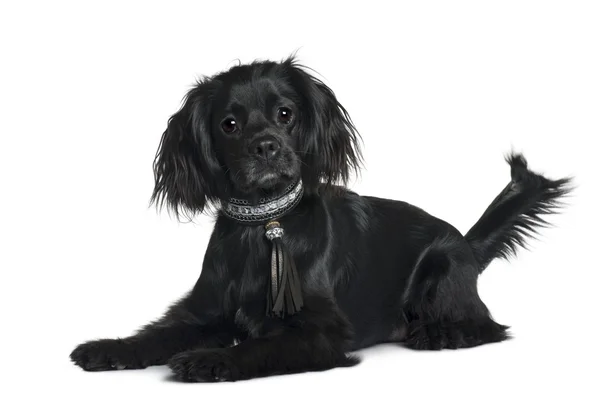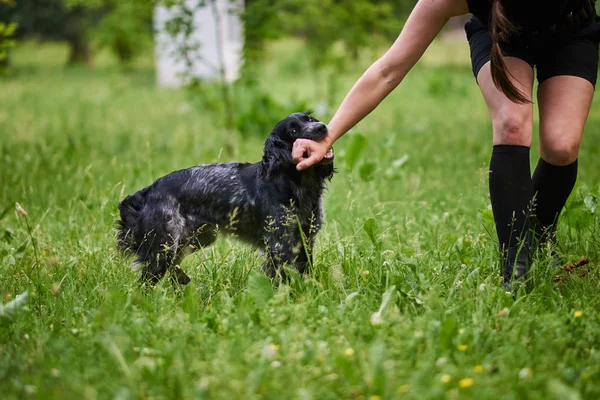The Markiesje Spaniel, a delightful blend of grace, affection, and an endearing charm, captures the hearts of dog enthusiasts and families alike. With a history as elegant as its gentle disposition and a distinctive appearance that exudes a touch of regal flair, this breed has earned its status as a cherished companion with a sophisticated spirit.

| Category (Explanation) | Breed Information |
|---|---|
| Year of Breed Conception | 1600s (Developed in the Netherlands) |
| Country of Origin | Netherlands |
| Weight (Male) | 13-18 lbs (6-8 kg) |
| Weight (Female) | 13-18 lbs (6-8 kg) |
| Coat Type | Medium-length, straight |
| Color Variations | Black with white markings |
| Shedding Level | Low to moderate |
| Height (cm & in) | 11-14 inches (28-36 cm) |
| Breed Size | Small to medium |
| Trainability | High |
| Mental Needs | Moderate |
| Intelligence Level | High |
| Energy Level | Moderate |
| Agility | High |
| Loyalty | High |
| Playfulness | Moderate to high |
| Exercise Needs | Moderate to high |
| Guarding Proficiency | Low |
| Sociability with Children | High |
| Barking Level | Low to moderate |
| Digging Tendency | Low |
| Destructive Behavior | Low |
| Drooling Level | Low |
| Obedience Level | Moderate to high |
| Apartment Friendly | Yes |
| Inherent Prey Drive | Low |
| Physical Risk to Others | Low |
| Travel Fatality Risk | Low |
| Allergen Potential | Low (considered hypoallergenic) |
| Health Concerns | Hip Dysplasia, Eye Issues |
| Average Life Expectancy | 12-14 years |
Woof Mastery is reader supported and our articles may contain affiliate links.
Instead of running third party ads that we have no control of we only use links from high-quality companies we are directly partnered with. Making use of these links come at no cost to you our reader, and in many cases have the extra benefit of discounted rates or sign up bonuses.
If you’re interested you can read more about our affiliate policy here.
We appreciate your support and always insure that the products and services we recommend are high-quality, helpful and relevant to the subject at hand!
The Markiesje Spaniel’s origin and history pay tribute to their Dutch heritage and role as cherished companion dogs. Emerging in the Netherlands in the 17th century, these spaniels were favored by Dutch aristocracy for their graceful appearance and amiable temperament.
Markiesje Spaniels gained recognition for their elegant and friendly disposition, becoming cherished pets in Dutch households. Their name, “Markiesje,” even suggests a connection to nobility.
In the mid-20th century, breed enthusiasts like Mr. K. G. P. Haring took measures to preserve and promote the Markiesje Spaniel breed. Their dedication ensured the continuation of these charming and personable dogs, solidifying their place as a beloved and distinctive breed.
Today, the Markiesje Spaniel stands as a testament to the enduring legacy of these elegant and affectionate dogs, embodying the spirit of Dutch companionship for countless families.

What sets the Markiesje Spaniel apart is its remarkable combination of elegance and affection. This breed’s graceful appearance and unwavering loyalty make it an ideal companion and beloved family pet.
Underneath its stylish exterior lies a heart full of devotion, making the Markiesje Spaniel truly special. In addition to its elegance, the Markiesje Spaniel’s cheerful disposition and lively spirit make it a delightful companion for people of all ages. Its graceful movements and devoted nature add a touch of joy to everyday life.
The Markiesje Spaniel’s traditional role in human society traces back to the Dutch Golden Age, often depicted in classic artwork. These graceful canines played refined roles in daily life, excelling as beloved companions of nobility.
Their elegance and gentle temperament made them favored confidants for the aristocracy, gracing palaces and manors. Over the years, their delicate beauty and charm earned them a reputation as esteemed and elegant pets.
This enduring legacy of elegance and poise continues today, as Markiesjes remain treasured family companions and show ring stars, embodying the spirit of the Netherlands’ regal history.
Markiesje Spaniels are renowned for their characteristic personalities. They are known to be delightfully graceful, deeply amiable, and inherently sociable among peers.
Despite their dainty appearance, they often convey a warmth and brightness that’s captivating. Their nimble demeanor, coupled with a serene spirit, makes them delightful companions in households. While they exude charm effortlessly, their bond with loved ones is genuine. Markiesje Spaniels are characterized by their delicateness, affability, and a spontaneous sense of joy.
With the right training and care, they can be elegant, warm-hearted, and delightful companions, epitomizing the perfect balance of finesse and friendliness.
Despite usually being gentle and social, their attentive nature, if not given proper outlets, can lead to alert barking at unfamiliar sounds.
This breed may show a graceful demeanor, and they can be sensitive at times, advocating for kind and reassuring training. Their petite size can be overlooked if not properly supervised, making close monitoring vital. Additionally, their friendly disposition may make them overly enthusiastic with newcomers, emphasizing gradual meetings.
While tender-hearted with their families, some Markiesje Spaniels can be anxious, underscoring the importance of early training and acclimatization.
Markiesje Spaniels are elegant, small-sized dogs with a graceful and dainty build. They showcase a refined head, more slender in females, and their hallmark facial features include a straight muzzle and twinkling eyes.
Their eyes are almond-shaped, predominantly in shades of dark brown, expressing curiosity and intelligence. Ears are set high, slightly drooping and covered with fine hair.
These dogs boast a glossy, straight coat, primarily in jet black. Their skin is smooth, accentuating their delicate structure, especially pronounced in males.
The Markiesje Spaniel’s neck is slender, leading to a narrow chest and lean, straight legs. Their tail, feathered, is carried elegantly behind them.
In terms of size, both males and females typically stand between 13 to 16 inches (33-41 cm) at the shoulder. Weight is light, usually between 13 to 20 pounds (6-9 kg).
Overall, Markiesje Spaniels epitomize petite beauty and agility. Their appearance radiates finesse and sophistication, with males often showcasing a more elongated frame.
Markiesjes come in various color variations, adding to their unique and distinctive appearance. The most common color variations for Markiesjes include:
Solid Black: This is the predominant coat color for Markiesje Spaniels, giving them a sleek appearance.
Bicolor: Although rarer, some might exhibit black with small white markings, typically on the chest and feet.
Tuxedo: Black with distinct white markings on the chest, paws, and tail tip.
Ticked: Some dogs may present small white spots on the predominantly black coat.
Patchy: These dogs have larger, irregular white patches on a predominantly black coat.
Parti-color: Large patches of black and white distributed randomly across the coat.
Markiesje Spaniels have a low to moderate shedding level. Unlike some heavy shedders, their shedding is relatively consistent, with a slight surge during the spring and fall. Shedding rates can vary among these spaniels.
Factors impacting shedding in Markiesje Spaniels include genetics, overall health, and the texture of their coat. Regular grooming is beneficial for shedding control. Brushing your Markiesje Spaniel weekly with a soft-bristle brush can assist in managing shedding.
The Markiesje Spaniel has a sleek and long coat, making grooming essential to its health and comfort. It’s prone to matting and tangling, so this breed isn’t ideal for busy individuals.
Brushing: Markiesjes have sleek, long coats. Brush them thrice a week to avoid matting. A bristle brush is suitable.
Bathing: Bathe them when they’re notably dirty. Use gentle shampoo, rinse well, and dry completely.
Ears: Their ears should be checked and cleaned consistently. Use an ear cleaning solution or damp cotton ball.
Nails: Regular trimming is crucial to ensure their nails don’t become too long. Just like its fur, avoid overgrowth as it can be painful for the dog.
Teeth: Brush their teeth regularly. Offer dental chews for added oral hygiene.
Eye Care: Their eyes should be observed for any issues. Use a damp cloth for cleaning if necessary.
Markiesje Spaniels, with their graceful demeanor, exhibit a balanced activity level. While not hyperactive, they enjoy regular movement. Here’s a look at their activity regimen:
Markiesje Spaniels are known for their elegance and intelligence. Markiesje Spaniels are moderately intelligent dogs. Their intelligence is characterized by their trainability, adaptability, and a gentle demeanor. Key points about their intelligence include:
In summary, Markiesje Spaniels may not be known for their working abilities, but their intelligence shines through their trainability, adaptability, and their gentle and affectionate nature. They are cherished companions for those seeking a loving and elegant pet.
Markiesjes enjoy tasks that demand attention. Brain games, interactive toys, and agility tasks can stimulate their keen minds.
Enter The Woof Mastery

Before bringing a Markiesje Spaniel into your home, it’s crucial to understand their needs. These dogs are gentle and sociable, making them unsuitable for isolation. Training and socialization are vital to curb their shy tendencies.
Health concerns, like eye problems, need monitoring. Potential owners should be prepared for grooming their sleek coat and be aware of their graceful demeanor. Responsible ownership includes providing ample love, attention, and a safe environment to ensure the well-being of these elegant, devoted companions.
Markiesje Spaniels, with their delicate appearance and charm, can surprise with their lively nature. Behavior largely hinges on aspects like individual temperament, training rigor, early experiences, and owner engagement. Considerations include:
Markiesje Spaniels are known for their gentle and affectionate nature, often making them great family pets. However, it’s crucial to supervise their interactions, especially with young children, as with any dog breed. Here are some key considerations regarding Markiesje Spaniels and their behavior with children:
Markiesje Spaniels, with their elegant appearance, can have varied reactions to water. Considering their swimming tendencies:
Though some Markiesjes might be curious about water, always evaluate individual dog comfort and capabilities. Safety and well-being should be paramount during any water activities.
Remember, Markiesje Spaniels, with their blend of agility and affection, flourish into charming companions when trained appropriately. Your consistent effort will pave the way for an inseparable bond, filled with love and trust.
Markiesje Spaniels, with their delicate demeanor, are not short of vocalizations that they use to communicate their feelings and daily experiences. Here’s a detailed look at these sounds:
It’s pivotal for owners of Markiesje Spaniels to understand these vocal nuances, ensuring they can cater to their pet’s needs appropriately. Positive reinforcement training can be an asset in fine-tuning these vocal behaviors.
Markiesje Spaniels, with their affectionate and gentle nature, flourish in homes that offer close companionship, moderate play sessions, consistent grooming routines, and early socialization. Challenges might arise if their need for companionship is overlooked or if their fine coat isn’t maintained. Care, gentle training, and an appreciation for their delicate beauty are paramount.
Challenges:
For the Markiesje Spaniel, a toy breed with a graceful demeanor, it’s essential to consider these potential travel constraints:
By understanding these potential constraints and enacting the necessary precautions, traveling with your Markiesje Spaniel can be a delightful experience.
Markiesje Spaniel are prone to specific health concerns. While not all individuals will experience these issues, it’s essential for Markiesje Spaniel owners to be aware of potential health problems and work with veterinarians to maintain their pets’ well-being. Common health concerns in Markiesje Spaniels include:
Regular veterinary check-ups, a balanced diet, proper exercise, and responsible breeding practices can help mitigate some of these health concerns. It’s crucial for Markiesje Spaniel owners to work closely with their veterinarians to monitor their pets’ health and address any issues promptly.
The graceful Markiesje Spaniel thrives when its diet mirrors its delicate nature. Key dietary habits to consider are:
Breed-Specific Laws (BSL): Markiesje Spaniels may potentially be impacted by breed-specific laws (BSL) in certain regions. These laws are often enacted at the local or municipal level and can exhibit substantial variations from one jurisdiction to another.
Types of Restrictions: The specific restrictions imposed on Markiesje Spaniels under BSL can encompass mandatory spaying/neutering, specialized licensing, liability insurance requirements, muzzling in public, and, in more severe cases, bans on ownership. The extent of these restrictions depends on local regulations and the perceived risk associated with the breed.
Rationale for BSL: BSL is typically instituted due to concerns about public safety and perceived risks linked to specific breeds, often stemming from incidents involving dog attacks. Markiesje Spaniels are known for their agility and intelligence. Nevertheless, they might still be impacted by BSL, mainly due to their relative rarity and potential confusion with other spaniel breeds that might be included in these laws.
Controversy: It’s crucial to recognize that BSL remains a contentious and divisive issue within the dog ownership community. Critics argue that it unfairly targets breeds rather than addressing individual dog behavior. They advocate for responsible ownership and training as more effective solutions than breed-specific restrictions.
Local Regulations: To determine if there are breed-specific laws or restrictions concerning Markiesje Spaniels in your area, it’s crucial to consult with your local animal control or government authorities. Staying informed about and adhering to local regulations is essential to ensure legal compliance while owning a Markiesje Spaniel.
Woof Mastery is reader supported and our articles may contain affiliate links.
Instead of running third party ads that we have no control of we only use links from high-quality companies we are directly partnered with. Making use of these links come at no cost to you our reader, and in many cases have the extra benefit of discounted rates or sign up bonuses.
If you’re interested you can read more about our affiliate policy here.
We appreciate your support and always insure that the products and services we recommend are high-quality, helpful and relevant to the subject at hand!
Myth 1: Markiesje Spaniels are Always Reserved and Shy
Myth 2: Markiesje Spaniels are Difficult to Train
Myth 3: Markiesje Spaniels are Not Good with Children
Myth 4: Markiesje Spaniels are Aggressive Towards Other Dogs
Myth 5: Markiesje Spaniels are Only Suitable for Active Owners
Myth 6: Markiesje Spaniels Require Extensive Grooming
Myth 7: Markiesje Spaniels are Prone to Health Problems
Myth 8: Markiesje Spaniels Cannot Live in Apartments
Myth 9: Markiesje Spaniels are Not Playful
Myth 10: Markiesje Spaniels are All the Same in Temperament
Lady Marquis: Lady Marquis was a Markiesje Spaniel from the 19th century, celebrated for her graceful appearance and friendly demeanor. She became a popular companion among European aristocracy, highlighting the breed’s regal charm.
Baron Black: Baron Black, a modern-day Markiesje Spaniel, gained recognition in the world of dog shows for his exquisite coat and conformation. He exemplified the breed’s beauty and poise in the contemporary canine competition arena.
Mister Markie: Mister Markie was a therapy dog known for his exceptional ability to bring comfort to individuals in hospitals and nursing homes. His gentle and affectionate nature represented the breed’s capacity for providing emotional support and companionship.
These famous dogs from each of the mentioned breeds have contributed to the breed’s historical significance and showcased their unique talents and characteristics, whether in hunting, dog sports, or therapy work. They continue to be celebrated as symbols of their respective breeds’ rich histories and capabilities.
Markiesje Spaniels hold cultural significance in various contexts:
Although there may not be as many famous Markiesje Spaniel owners as there are for other dog breeds, here are a few notable individuals who have been associated with Markiesje Spaniels:
Markiesje Spaniels, known for their elegant appearance and affectionate nature, face a set of challenges that require dedicated efforts from breed enthusiasts. Some of the most significant dangers the Markiesje Spaniel breed encounters include:
The Markiesje Spaniel, a Dutch breed with a long history, is believed to have been developed from a combination of the Pekingese, Schipperke, and various local spaniels. This mix of breeds resulted in a charming and agile companion dog with distinctive traits.
Pekingese: The Pekingese’s regal appearance and dignified demeanor likely influenced the Markiesje’s refined features and elegant bearing. This breed’s influence is seen in the Markiesje’s coat texture and overall appearance.
Schipperke: The Schipperke, with its small size and lively personality, may have contributed to the Markiesje’s compact stature and playful nature. It added an element of liveliness to the breed’s personality.
Various Local Spaniels: Local spaniels from the Netherlands likely contributed regional adaptations and temperament traits to the Markiesje’s heritage. These local influences made the Markiesje a beloved companion with Dutch origins.
Markiesje Spaniels are a symphony of elegance and unwavering affection. Their deep connection and sensitivity towards their human counterparts make them exceptional confidants. Their alertness ensures that our homes remain safe havens under their watch.
With their mild and affectionate temperament, they are naturals at bonding with families, especially endearing themselves to the younger lot. They gracefully fit into varying environments, with their silken coat demanding basic care. They resonate with active families due to their nimbleness, and their sharp wit ensures they stand out in tasks and training.
Beyond their ethereal beauty, Markiesje Spaniels exude a warmth that becomes the soul of the household. They masterfully balance their roles, from doting pets to agile performers in the field.
Embedded in their essence is an unwavering bond of trust and love. They evolve from pets to becoming the heartbeats of our homes. Delve into the serene world of Markiesje Spaniels.